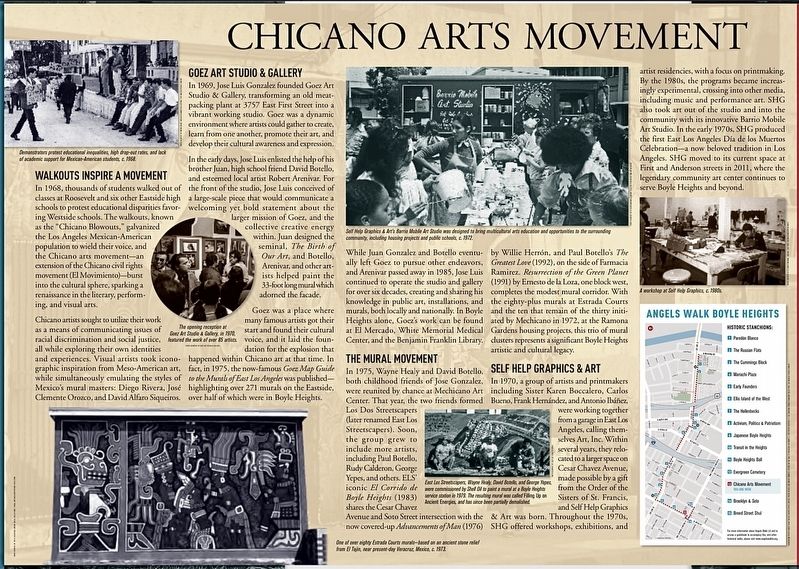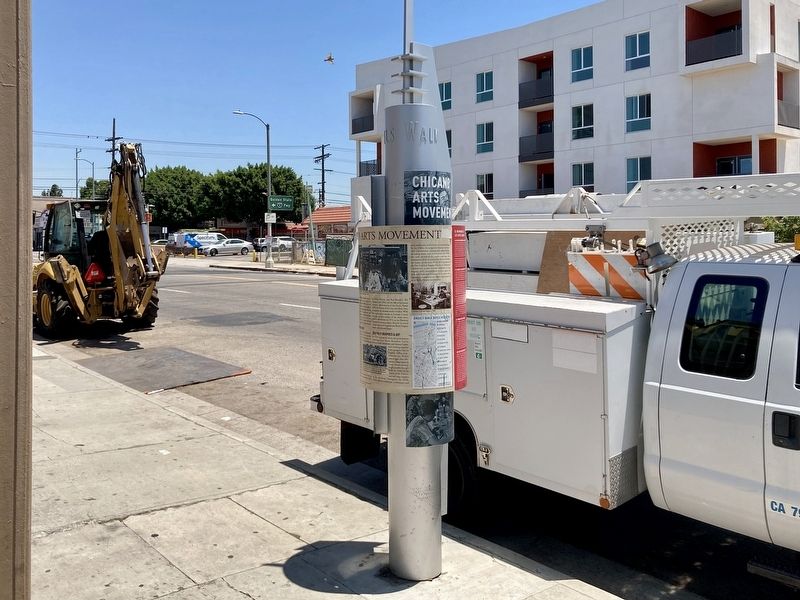Boyle Heights in Los Angeles in Los Angeles County, California — The American West (Pacific Coastal)
Chicano Arts Movement
Walkouts Inspire a Movement
In 1968, thousands of students walked out of classes at Roosevelt and six other Eastside high schools to protest educational disparities favoring Westside schools. The walkouts, known as the "Chicano Blowouts," galvanized the Los Angeles Mexican-American population to wield their voice, and the Chicano arts movement - an extension of the Chicano civil rights movement (El Movimiento) - burst into the cultural sphere, sparking a renaissance in the literary, performing, and visual arts.
Chicano artists sought to utilize their work as a means of communicating issues of racial discrimination and social justice, all while exploring their own identities and experiences. Visual artists took iconographic inspiration from Meso-American art. while simultaneously emulating the styles of Mexico's mural masters: Diego Rivera, José Clemente Orozco, and David Alfaro Siqueiros.
Goez Art School & Gallery
In 1969, Jose Luis Gonzalez founded Goez Art Studio & Gallery, transforming an old meat. packing plant at 3757 East First Street into a vibrant working studio, Goez was a dynamic environment where artists could gather to create, lean from one another, promote their art, and develop their cultural awareness and expression.
In the early days, Jose Luis enlisted the help of his brother Juan, high school friend David Botello, and esteemed local artist Robert Arenivar. For the front of the studio, Jose Luis conceived of a large-scale piece that would communicate a welcoming yet bold statement about the larger mission of Goez, and the collective creative energy within. Juan designed the seminal, The Birth of Our Art, and Botello. Arenivar, and other artists helped paint the 33-foot long mural which adorned the facade.
Goez was a place where many famous artists got their start and found their cultural voice, and it laid the foundation for the explosion that happened within Chicano art at that time. In fact, in 1975, the now-famous Gorz Map Guide to the Munals of East Los Angeles was published - highlighting over 271 murals on the Eastside, over half of which were in Boyle Heights.
While Juan Gonzalez and Botello eventually left Gorz to pursue other endeavors, and Arenivar passed away in 1985, Jose Luis continued to operate the studio and gallery for over six decades, creating and sharing his knowledge in public art, installations, and murals, both locally and nationally. In Boyle Heights alone, Goez's work can be found at El Mercado, White Memorial Medical Center, and the Benjamin Franklin Library.
The Mural Movement
In 1975, Wayne Healy and David Botello, both childhood friends of Jose Gonzalez, were reunited by chance at Mechicano Art Center. That year, the two friends formed Los Dos Streetscapers (later renamed East Los Streetscapers). Soon, the group grew to include more artists, including Paul Botello, Rudy Calderon, George Yepes, and others. ELS’ iconic El Corrido de Beyle Heights (1983) shares the Cesar Chavez Avenue and Soto Street intersection with the now covered-up Advancements of Man (1976) by Willie Herrón, and Paul Botello's The Greatest Love (1992), on the side of Farmacia Ramirez. Resurrection of the Green Planet (1991) by Emesto de la Lora, one block west, completes the modest mural corridor. With the eighty-plus murals at Estrada Courts and the ten that remain of the thirty initiated by Mechicano in 1972, at the Ramona Gardens housing projects, this trio of mural clusters represents a significant Boyle Heights artistic and cultural legacy.
Self Help Graphics & Art
In 1970, a group of artists and printmakers including Sister Karen Boccalero, Carlos Bueno, Frank Herández, and Antonio Ibáñez, were working together from a garage in East Los Angeles, calling themselves Art, Inc. Within several years, they relocated to a larger space on Cesar Chavez Avenue, made possible by a gift from the Order of the Sisters of St. Francis, and Self Help Graphics & Art was born. Throughout the 1970s, SHG offered workshops, exhibitions, and artist residencies, with a focus on printmaking. By the 1980s, the programs became increasingly experimental, crossing into other media, including music and performance art. SHG also took art out of the studio and into the community with its innovative Barrio Mobile Art Studio. In the early 1970s, SHG produced the first East Los Angeles Dia de los Muertos Celebration — a now beloved tradition in Los Angeles. SHG moved to its current space at First and Anderson streets in 2011, where the legendary community art center continues to serve Boyle Heights and beyond.
Erected 2019 by City of Los Angeles.
Topics. This historical marker is listed in these topic lists: Arts, Letters, Music • Civil Rights • Education • Hispanic Americans. A significant historical year for this entry is 1968.
Location. 34° 2.773′ N, 118° 12.5′ W. Marker is in Los Angeles, California, in Los Angeles County. It is in Boyle Heights. Marker is on Soto Street south of Cesar E Chavez Avenue, on the right when traveling south. Touch for map. Marker is at or near this postal address: 245 N Soto St, Los Angeles CA 90033, United States of America. Touch for directions.
Other nearby markers. At least 8 other markers are within walking distance of this marker. Brooklyn & Soto (about 400 feet away, measured in a direct line); Brooklyn Avenue (about 400 feet away); Otomisan Restaurant (approx. ¼ mile away); Japanese Hospital (approx. ¼ mile away); The Hollenbecks (approx. 0.3 miles away); Japanese-American Soldiers (approx. half a mile away); Hollenbeck Park (approx. half a mile away); Mariachi Plaza (approx. 0.6 miles away). Touch for a list and map of all markers in Los Angeles.
Also see . . . Angels Walk L.A. Self-guided walking tours of historic neighborhoods in Los Angeles. The Chicano Arts Movement marker is part of the Boyle Heights walk. (Submitted on July 16, 2023.)
Credits. This page was last revised on July 16, 2023. It was originally submitted on July 16, 2023, by Craig Baker of Sylmar, California. This page has been viewed 112 times since then and 43 times this year. Photos: 1, 2. submitted on July 16, 2023, by Craig Baker of Sylmar, California.

